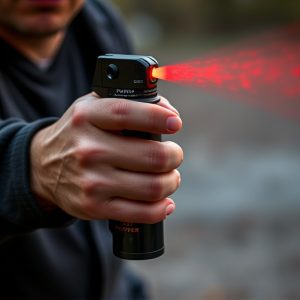Tactical Pepper Spray: Effective Deployment Methods for Personal Protection
Tactical pepper spray, a powerful self-defense tool, relies on its chemical irritants and delivery s…….
Tactical pepper spray, a powerful self-defense tool, relies on its chemical irritants and delivery systems. Key deployment methods include aerosol cans and advanced ballistic models, ensuring precise application for maximum impact while minimizing collateral damage. Effective use requires understanding both the chemical composition and unique features of these methods, such as targeted spraying at eyes, face, or respiratory areas, with adjustable nozzles and triggers for strategic control. Proper training, gear selection based on specific needs, safety measures like protective gear, ventilation, and "point and shoot" techniques, along with responsible disposal, are essential for optimal personal protection using tactical pepper spray deployment methods.
In today’s world, personal protection is paramount. Among various self-defense tools, tactical pepper spray stands out as a potent chemical irritant, designed to incapacitate aggressors temporarily. This article delves into the critical role of chemical irritants in personal safety devices. We explore tactical pepper spray as a powerful and effective deterrent, highlighting its deployment methods and strategic use. Additionally, we guide readers on choosing the right spray and provide essential safety precautions for responsible handling, focusing on key aspects like Tactical Pepper Spray Deployment Methods.
- Understanding Chemical Irritants: Their Role in Personal Protection
- Tactical Pepper Spray: A Powerful Tool for Self-Defense
- Deployment Methods: Effective Use Strategies
- Choosing the Right Pepper Spray for Your Needs
- Safety Precautions and Responsible Handling Techniques
Understanding Chemical Irritants: Their Role in Personal Protection
Chemical irritants play a pivotal role in personal protection devices, especially tactical pepper spray. These substances are designed to disrupt an attacker’s senses and provide crucial time for escape or assistance. Understanding chemical irritants is essential when considering their deployment methods in self-defense scenarios. Tactical pepper spray, for instance, uses capsaicin, the active ingredient in chili peppers, to cause a burning sensation and temporary blindness, giving users an opportunity to retreat safely.
The effectiveness of these irritants depends on their delivery systems. Modern tactical pepper spray devices employ various deployment methods, such as aerosol cans or advanced ballistic models, allowing for precise and efficient application. This ensures that the irritant reaches its target with minimal spread, maximizing its impact while minimizing collateral damage. Effective tactical pepper spray deployment requires users to understand not just the chemical composition but also the unique features of their chosen delivery mechanisms.
Tactical Pepper Spray: A Powerful Tool for Self-Defense
Tactical pepper spray is a versatile and potent self-defense tool designed for law enforcement, military personnel, and civilians seeking personal protection. Its primary function is to disable an assailant temporarily through irritation, allowing users to escape or subdue their attacker. The deployment methods of tactical pepper spray are varied and effective, making it a valuable addition to any personal safety arsenal.
Spraying techniques involve targeted applications, ensuring the user aims for the eyes, face, and respiratory areas. The range and reach of modern tactical pepper sprays cater to different scenarios, from close-quarters combat to longer-distance deterrents. Users can employ quick, controlled releases or burst modes for maximum impact, depending on the situation’s urgency and intensity. These deployment methods, combined with proper training, enable individuals to utilize tactical pepper spray as a reliable means of self-defense in various environments.
Deployment Methods: Effective Use Strategies
Tactical pepper spray is a versatile chemical irritant used in personal protection devices, offering a swift and effective deterrence against potential threats. The deployment methods play a crucial role in ensuring its optimal use. One common tactic involves using spray canisters equipped with various nozzles and triggers for targeted application. Users can choose between a burst or stream setting, allowing for precise control over the spray pattern and range.
For tactical situations, rapid deployment is key. Training individuals to activate the spray from different stances and distances enhances their ability to respond quickly in high-pressure scenarios. Practicing with realistic simulations helps users understand the effective range and wind conditions that influence pepper spray’s performance, ensuring its strategic use in self-defense or law enforcement operations.
Choosing the Right Pepper Spray for Your Needs
When selecting a tactical pepper spray, understanding your specific needs and deployment methods is crucial. Different scenarios require varying levels of force and range, so it’s essential to choose a product tailored to your intended use. For close-quarters combat, a smaller can with a powerful punch might be suitable, while longer-range protection calls for a larger container with a stronger spray stream.
Consider the deployment methods you plan to employ. Will you carry it in a holster or attach it to your gear? Are you familiar with the spray’s range and effectiveness at different distances? Knowing these factors will ensure you’re equipped with the right tactical pepper spray, enhancing your personal safety and deterring potential threats effectively.
Safety Precautions and Responsible Handling Techniques
When handling chemical irritants like tactical pepper spray, safety precautions are paramount. Always wear protective gear, including gloves and eye protection, to minimize direct contact with skin and eyes. Ensure proper ventilation in the area to prevent inhalation of harmful fumes. Familiarize yourself with the spray’s deployment methods, such as the “point and shoot” technique, allowing for accurate targeting while maintaining a safe distance. Regularly inspect and maintain your personal protection devices to ensure they remain effective and functional.
Responsible handling involves understanding the spray’s active ingredients and their effects on human health. Avoid aiming at sensitive areas like the face or eyes of others. Keep the spray can out of reach of children and unauthorized individuals. After use, thoroughly wash affected areas and seek medical attention if necessary. Proper disposal methods should be followed to prevent environmental contamination.
In conclusion, tactical pepper spray has established itself as a reliable chemical irritant for personal protection devices. Understanding its role in self-defense and mastering deployment methods are crucial steps towards ensuring safety. By choosing the right pepper spray tailored to your needs and adhering to safety precautions, you can effectively deter potential threats. Remember, proper handling techniques are key to maximizing its effectiveness during tactical situations, making it an invaluable tool for personal protection.


